A Paipo
Interview with Barry Regan
August 10, 2010. Ballina NSW, Australia
Questions and telephone interview by Bob Green
Barry started surfing on wooden boards before progressing
to a malibu
board [see Note 1]. In 1999, Barry went back to
building and riding hollow ply
boards.
|
1. When
did you start surfing?
Approximately
1942,
1943.
Where was
this?
The first time I
had a ride on a surfboard was when my mother's sister had a holiday
home at Curl Curl. We went over there during the Christmas holidays.
There was a 6'6" pine surfboard there. Some other kids and myself we
used to surf it. I've seen a very similar board to that at surf museum
at Currumbin.
2. What did you surf on
then?
Around that time I
surfed on some hollow longboards that had been left at the surf club by
guys who were in the Army. We would take advantage of the fact that
they weren't around and use them.
How were you surfing them?
There were a couple there that were the solid redwood variety, of the
mal shape, about 9-foot long. Big heavy boards.
We'd used to carry them down to the beach, a couple of kids to do that.
Then we'd stand in the broken water because we couldn't paddle them.
They were too heavy. We'd just launch them on a broken wave and jump up.
|
|
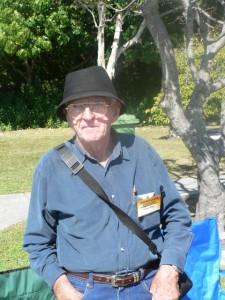
Barry
Regan August 2010 at the
Currumbin Wooden Board
Day.
Photo
by Bob Green.
|
How long did you
do that before you got your first
board?
I got my first personal board when I was about 16 or 17 years old.
Who made the board?
It was 16-foot long that was made by Mulcay Brothers from Maroubra. It
cost me 10 pounds. It was a hollow ply board.
Is that like the boards you ride now?
Yeah, but it was 16-foot and what I'm riding now are the precursors to
that board. The twelve footers.
So you are riding an older style board now?
That's right.
3. I was interested that you
said that the 1956 U.S. Olympic team came to Cronulla. How many of the
team actually came to Cronulla?
It was the United
States and Hawaiian surfing teams. The two complete teams came. I'd say
about 30 people all up
Did they stay at Cronulla?
They only stayed at Cronulla for the day. It was just a welcome to
Australia day.
4. You mentioned on the
weekend that they brought a couple of paipo boards?
They did indeed.
Can you tell me what the boards were like?
I
can do even better than that. I have a photo of one of them here. They
were about 3'6" long. They would have been 22" wide, they had parallel
sides, were finned, with parallel keel fins that were rounded and not
necessarily foiled (with a left or right side), and made of balsa. They
had two cedar stringers in them and they were fibreglassed. They were
stored at the Cronulla club ballroom along with the other boards. [See Note 2.]
1956
U.S.-Hawaiian lifeguard team boards stored at Cronulla S.L.S.C. The
paipo board is in the center.

Photo
by Barry Regan, courtesy Garry Birdsall.
5. Did they surf the boards at
Cronulla?
Not that I am aware
of.
So when guys copied the boards it must have been on
the strength of what they looked like?
Yeah.
You've said it was about 2 to 3 weeks after the visit
that local guys appeared with copies of the boards?
About 4 to 5 guys that I know of made and rode paipo boards.
Can you recall their names?
Lloyd Webster, Ronnie Bowler, Neal Stenhouse and Nigel Dwyer. He was a
bit younger than the others. He later became
a board shaper. His board was a balsa one which was almost a replica of
one of the Hawaiian paipo.
Do you know who he went on to shape with?
No. He worked for a lot of people. He has his own board factory in New
Zealand now. He has been over in New Zealand since 1964.
So there were about 4 or 5 guys who took up
bellyboards fairly quickly. Were there many others?
No. But, I did remember there was a guy from Bondi, called Russell
Hogg,
who made and rode one.
6. I have spoke to another guy
from Cronulla who made bellyboards around 1964. How long were they
around for?
Not much later than
then. They were starting to wane around then.
7. One of the reasons that you
said they waned was shorter boards and competition for the same
take-off spot.
In the days we were
riding 16-footers there weren't any problems because by the time the
wave started to break we
were more out on the shoulder of the wave. So we weren't in the same
takeoff area they were in. There was plenty of room for everybody.
Once guys started riding shorter boards everyone was trying to catch
the same wave. It closed off the takeoff area.
You'd mentioned there were a few arguments.
There were a few at one stage. In the early-1960s, some time.
[See Note 3.]
8. Was there much variety in
the bellyboards?
Did you ever try
one yourself?
I didn't ride one consistently. One day I just asked a guy if I could
have a ride on his board.
What was it like?
It was good, I enjoyed it but I wasn't that interested. I have
basically always been a stand-up surfer. But I have
surfed just about everything that floats.
You mentioned you had used handboards for a while. How
do they work?
They were about 9 to 10 inches long and that wide.Shaped with a pointy
sort of nose on them. They used to put a little
strap on them so you slip your hand into them, on the back of it. That
meant you could also use it as a hand fin when you were swimming and
when you took off on a wave, you put two hands out front. That meant
with the hand fin and flippers on, if you arched your back, you lifted
the main part of your body above the wave and you really powered along.
9. You also mentioned swim
fins made a big difference and this was a reason guys got into
bellyboards.
That's right.
When did you first see swim fins?
About 1949. Dick Turnbull's were the first I saw. He made them and then
commercially made them. I think they were
called Turnbull swim fins.
Where was he based?
He came from Bondi.
So Bondi would have been a place where bellyboards
would have got a start because swim fins were introduced?
Bondi was very popular area with surfcraft so they would have used
everything there.
What difference did fins make?
They placed you above the water and increased acceleration. People who
were not as fast a swimmer could surf onto a
wave and maintain position on a wave - lower on a wave. There were also
handboards - these lifted you out of the water so just your hands and
feet were in the water. There was also the surfoplane. [See Note 4.]
So what would it have been liked trying to catch waves
without swim fins?
Very, very difficult. With swim fins on you paddle onto the wave early.
Without swim fins you are reliant on
catching the wave as it begins to curl. Late take-offs all the time.
10. Were bellyboards just
ridden straight or were they able to ride in the tube.
They were able to
ride inside out.
11. You travelled a fair bit.
Did you see bellyboards anywhere else?
I did not.
12. How old are you now?
Almost 81.
And you are still surfing?
Yes.
What sort of board are you riding?
A 12-foot hollow board with a square back on it. A Tom Blake Beach Boy
board.
The Barry Regan
'Tom Blake Model' boards (each measures 12 foot by 23 inches):
"Beach
Boy" and "Waverider Model"
|
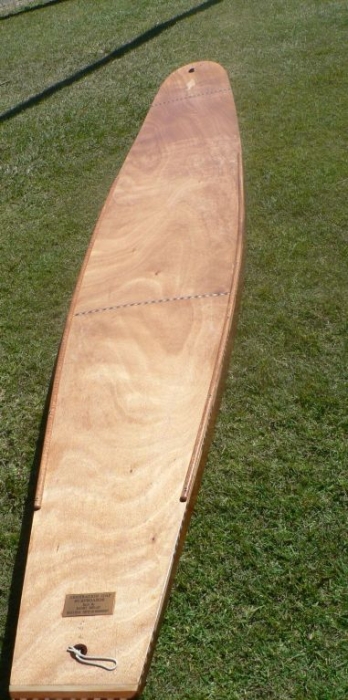
|
|
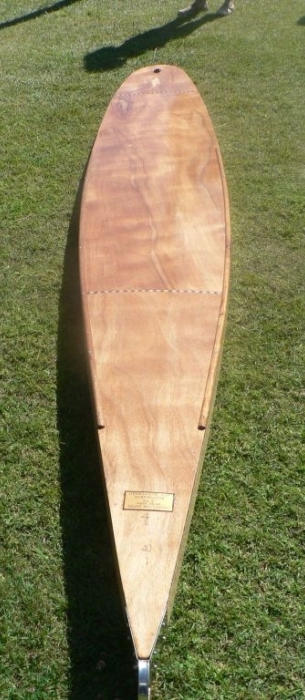
|
Photos
by Bob Green.
13. How long have you been
making wood boards for?
I started making the
odd wood board in the 1950s. In 1999, I made my first wood board for a
long time. I made it
because different ones had asked me about them so I thought I'd make
one and see we go. I made it in the shape of a 1940s-era board that I
remembered well. Twelve foot long and I took it out and surfed it. I
discovered that I thought it wouldn't be like it was going to be - just
jump on and surf it like it was a mal It took me quite a while to
re-discover my surfboard riding skills for that type of board.
It was while riding that one
at Byron Bay, at the Pass which is one of one of the breaks that I surf
regularly, that I ran into an American
tourist who was enamoured of the board. I let him have some waves on it
and then he asked me if I would make him one. Then a couple of locals
asked me to make them boards for them. So I started making boards again.
What's the actual construction?
The materials and the glues and the fasteners that are around today are
far superior than they have ever
been. So it is possible to make the boards better than we ever made
them. I basically glue everything together. I don't use fasteners
inside. I just use glue and cramps to hold it together.
No screws?
The only screws are in the battens that run along the top of the deck.
14. Have you boards got longer?
No. When I started
surfing, it was about a 12-footer. Then it turned into a 14-footer,
then a 16-footer as racing
became very popular and people wanted to go faster. Then the mals came
along and we went back to 10-foot, 9-foot again. So the board I made
when I first started again in 1999, was 12-foot long. Pretty much stuck
around that length. I've made a couple of specials, 16-footers, for
people who wanted boards exactly like we made in the 1950s.
Barry
ca. 1957, with his 16' x 21" 'Wave rider" board, at Cronulla before the
development. Racing boards were narrower.
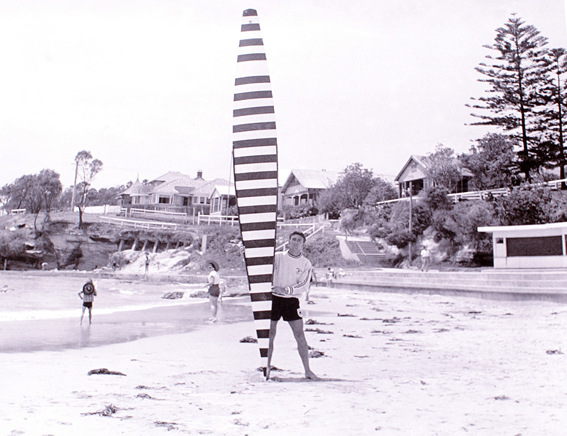
Photo
by Barry Stackelberg.
15. Any general comments
It's advanced in
leaps and bounds but I'm glad that I had my day because I had the best
of it. There were so many
places where you would go to lonely beaches and you would be the only
one there. Lonely points. I surfed a lot of places in Queensland.
Lonely points. I remember surfing Noosa with just a mate of mine. A
perfect surf of about 4 to 5 foot up there. Then we came back down,
surfed
Alexandra Headlands, the point down there. There were only two of us
out. We surfed Greenmount the same way.
You wouldn't get it like that now with the crowds.
Well I enjoy the fellowship of it and because I ride a board that I can
take off earlier and wider than everybody
else I don't have much problem with people.
So you still have company but avoid the crowd.
That's right.
Thanks for your insights.
When you asked me if I had ridden a bodyboard, yes I have ridden a
bodyboard. I have ridden surfo's, I've ridden mats,
I've ridden surfskis, I've swept surfboats, I've done everything that
you sort of can in the surf. I'm the sort of guy, who don't see much of
today. I'm likely to go out on my board and have a surf, then come in
and have a couple of waves on the body.
You don't see many good bodysurfers around these days.
No, they don't learn to do it. Terrible.
Some of the attraction of bellyboards and handboards
was that they were an enhanced form of bodysurfing.
That's exactly right. Most of the guys who took up bellyboards and used
the handboards were exceptionally good
bodysurfers. I've seen the days when we used to get closeout surf signs
on the beaches. And you could go to just about any beach and you
could probably find a handful, or might have only been 3 to 4 guys who
would go out into those enormous surfs and surf those waves on the
body. It took an enormous amount of skill to do that. And another
thing, the leg-rope's been wonderful but it means any idiot can go out
in the surf and doesn't have to worry about swimming if he loses it.
Most of these young guys today if they lose their board they can't
surf. I was one of the earliest surfers on Lennox Point but I can
recall on a couple of occasions going out on that point and making
about three rescues before I even got a wave, because guys lost their
boards and couldn't swim. That's the last place to go out if you can't
swim and climbing up those rocks isn't a lot of fun. That's why I
haven't surfed there for years. Last time I surfed there I
put my foot down a hole and ripped a great chunk of skin off my shin. I
said, "I'm never going out here again." It's about one of the worst
places for entry and exit from the water that I have ever come across.
That was about 20 years ago. I haven't there for a long, long time.
Every now and then I look at it. When were coming home on Sunday,
coming back from the board day, there was a wonderful wave there and I
said to
my son, "I'd love to get out there and get one of those."
Barry's
logo.
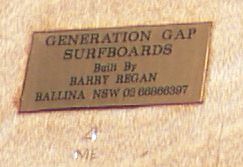
Photo
by Bob Green.
The
story of the 1958 restored paipo. Telephone call
with Barry on August 19, 2010
There's a paipo board
around the Ballina area somewhere. I saw it when it was being restored
in a board factory here and the guy restoring it called me over to have
a look at it.
What sort of board was it?
It was an Hawaiian paipo.
It was a wooden one?
A balsa one.
16. So it was a balsa, rather
than
a ply laminate one?
A proper balsa one
from the States. It was owned by someone locally and I'm suspecting
it's one of the two boards that was down in Cronulla Surf Club (brought
by the visiting 1956 U.S./Hawaiian Olympic team). I'm going to go
around
to the guy who restored the paipo board and find out who owns it and
take some photos of it.
17. Telephone
call with Barry on August 15, 2010, and updated
by Colin on March 3, 2011
Colin Harper bought
the bellyboard in Manly, New South Wales, in 1958, at the age of 12. He
rode it standing up 'til he was about 15, and approximately 50 kgs.
Finally talked into getting a "real" board by his mates the bellyboard
ended up under his mother's house in Manly for about 10 years, then
spent the next 40 years out on a farm in Cowra where he went to live.
He finally restored it in 2009. The excellent glassing job and original
volan glass fibre was done by Phil Way in Ballina. Col now lives in
Lennox Head and has made a comeback on a 9'6" mal and can't even kneel
on the bellyboard.
Colin Harper c
1958 and 2010
|
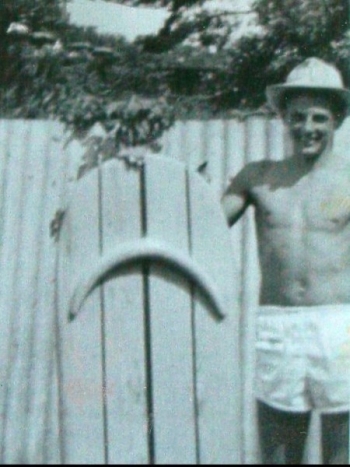 |
|
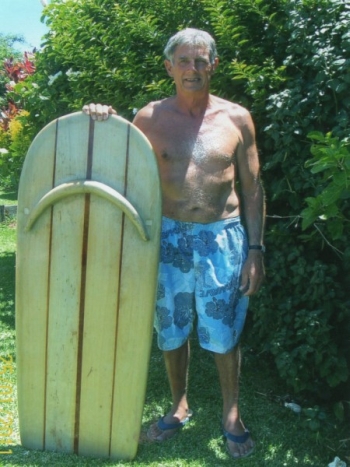
|
Photos
courtesy of Colin Harper.
I knew of this board and had seen it. He didn't even know it was called
a paipo until I told him it was a paipo. Then he looked it up and found
a photo of Wally Froiseth riding one in the Nat Young surfing book, the
first one called the History of Surfing. He didn't know of any
other
guys riding bellyboards about Manly at that time.
I wasn't surprised when I saw the board, how and when he got it, which
was two years after the American and Hawaiian teams were here. They
sold off most of their boards before they went back to the states. They
were staying over on the north side so the guys on the northside scored
all the boards. So this is why I think this paipo is an original one
because it looks so much like the real McCoy. It was in a really bad
way before this guy restored it. He had it valued by some surfboard
assessor who said it was worth between $3,000 and $4,000 dollars.
The restored
paipo
|
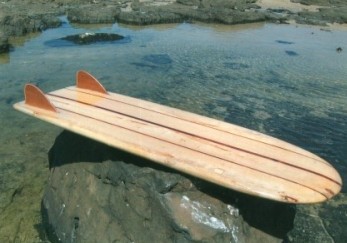
|
|
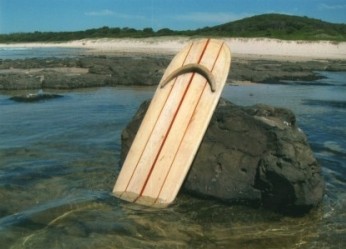
|
Photos
courtesy of Colin Harper.
Colin Harper added to the story by saying he bought the paipo, which
had been advertised in the Manly Daily. It was similar to a board
ridden by two locals whose boards had the words "Gus" and "Goose"
respectively on them. Ray Moran of the Manly Surf Museum was able to
advise that Gus and Goose were: Gus Garland and Graham Allen. Tony
Dawes from Manly, recalled that his friend Billy McMahon told him that
Goose rode his board stand up while Gus rode prone. Colin added "The
reason I bought the board was I was so impressed by Gus Garland and
Goose Allen as we discussed on the phone."
Note 1: In America, a Malibu board is short for
"Malibu chip," meaning virtually any of the balsa-core boards built
between the late-1940S and the mid-1950s, by Bob Simmons, Matt Kivlin,
Joe Quigg, and a
small number of other Southern California surfer/board-makers who often
rode at Malibu. A Malibu chip was usually about 10 feet long and 22
inches wide, with a blocky squared-off tail, and weighed between 25 and
30 pounds. In Australia and New Zealand, a Malibu, or "mal," is
synonymous with "longboard." Source: Warshaw, Matt. 2003. The encyclopedia of
surfing, page 361, Orlando, Fla: Harcourt.
Note 2:
Dave Jackman identified Tommy Zahn as riding a 4-foot twin-finned paipo
when the U.S. Olympic team visited Australia in 1956 (source: James,
Marcus (2011). A Waterman's Life: Dave Jackman. Pacific
Longboarder, 14(4), 54-59.).
Jim Growney, an Hawaiian paipo rider from the 1960s, confirmed that
Tommy Zahn rode a paipo similar to those made and ridden by Wally
Froiseth (Jim Growney,
personal communication, March
14, 2011). However, John Clark spoke to Tim Guard from
the Outrigger Duke Kahanamoku Foundation (John Clark, personal e-mail,
August 25, 2010), who advised Guard had ridden a paipo at Manly during
the 1956 trip. John also spoke to Wally Froiseth who stated that he
hadn't made Tommy Zahn a paipo and wasn't aware of him riding a paipo
(John Clark, personal e-mail, March 26, 2011).
Note 3: To read more about how
bodysurfers tried to thwart surfboards taking over see p. 198 in
Lester, Gary. (2007). The Cronulla Story: 100 years of surf
lifesaving, vigilance and service. Caringbah, N.S.W.: Playright
Publishing. This history
of Cronulla Surf Lifesaving Club also contains additional information
and photos of Barry 'Ripples' Regan.
Note 4: For more information on
hand boards and surfo planes (commonly known at surf mats) see the MyPaipoBoards.org home page and Wave
Riders: Intimacy or Evolution -- It's All in the Eye of the Beholder,
which show several forms of waveriding.
|
I am aware that some of the images and other content on this website may be subject to copyright and
will gladly remove any such items if so requested by the genuine holder
of the rights. Such content is not used for commercial exploitation. The sole purpose is to share knowledge with enthusiasts and interested parties. To the extent possible copyright holders have been contacted for permission to share content on this website. Likewise please respect the copyright content of this site.
|
All
contents of this site ©1998-2025 Rod's Home Port
for SurfMarks and MyPaipoBoards.
All
images within this section copyright of
respective
credited contributor.
|
|
Last updated
on: 07/31/13
|